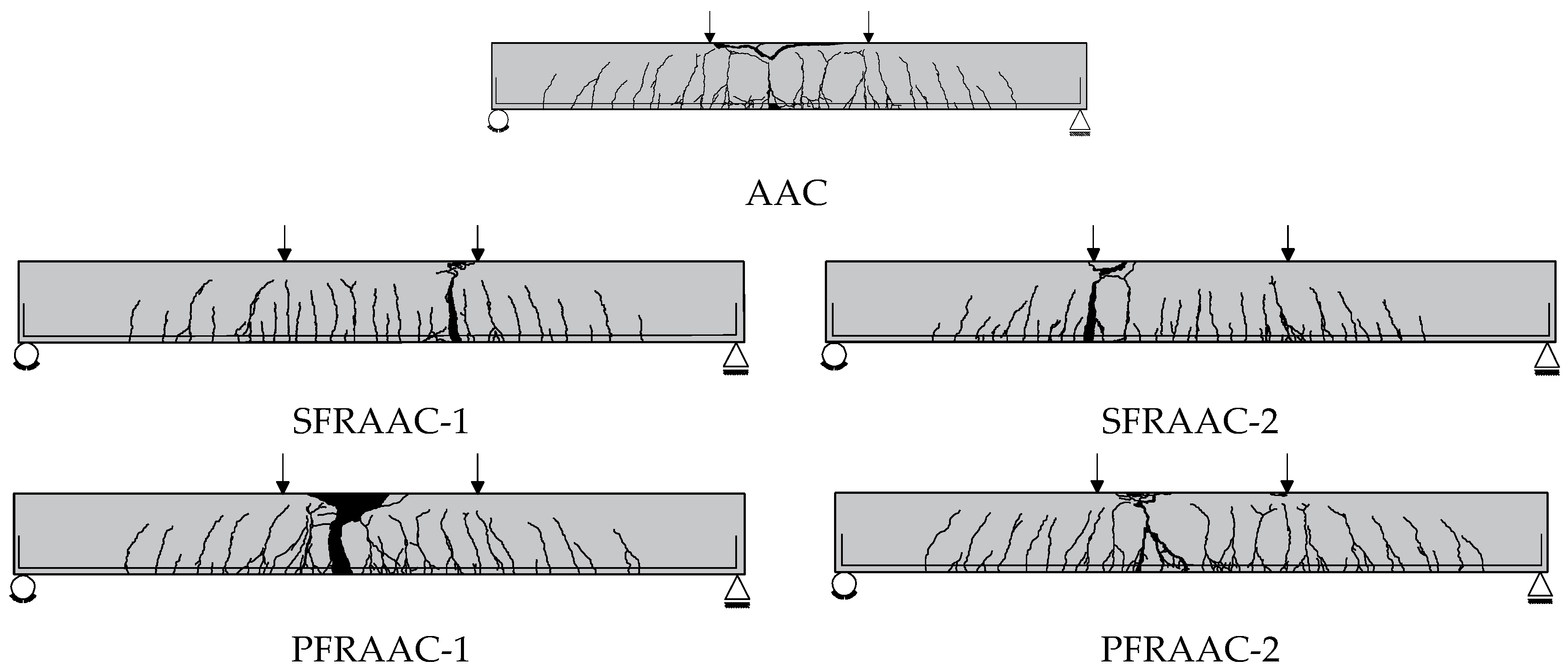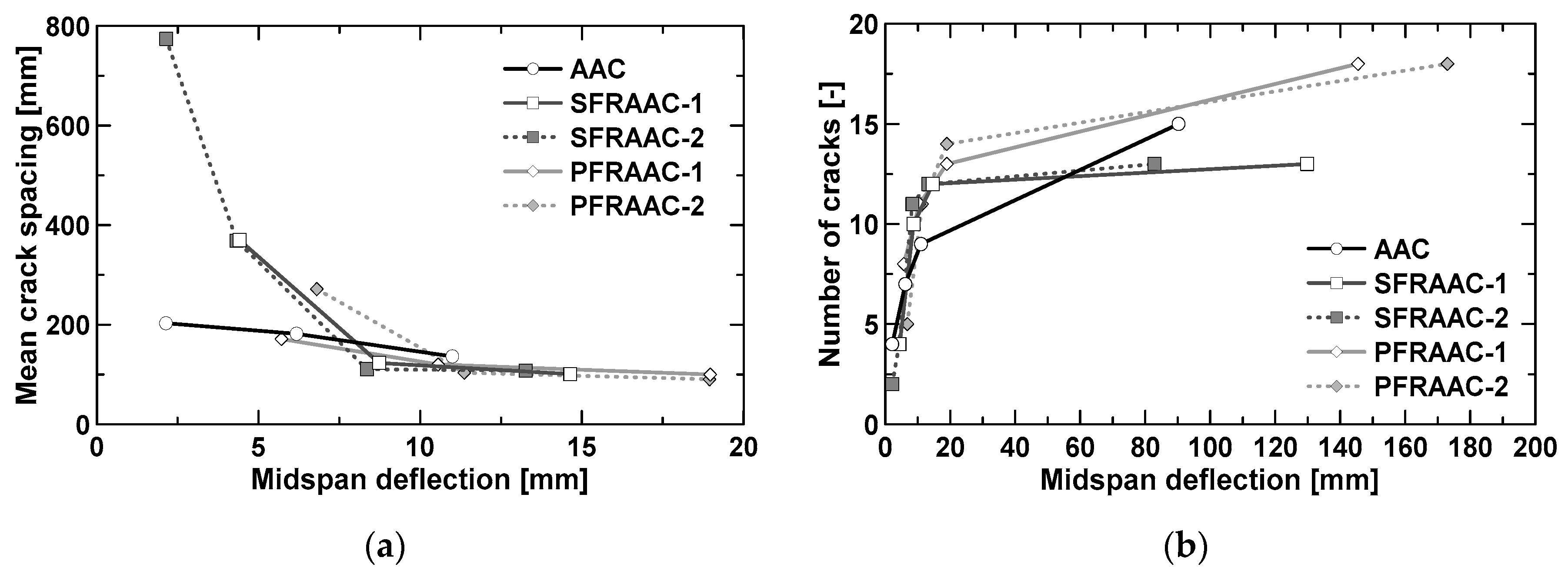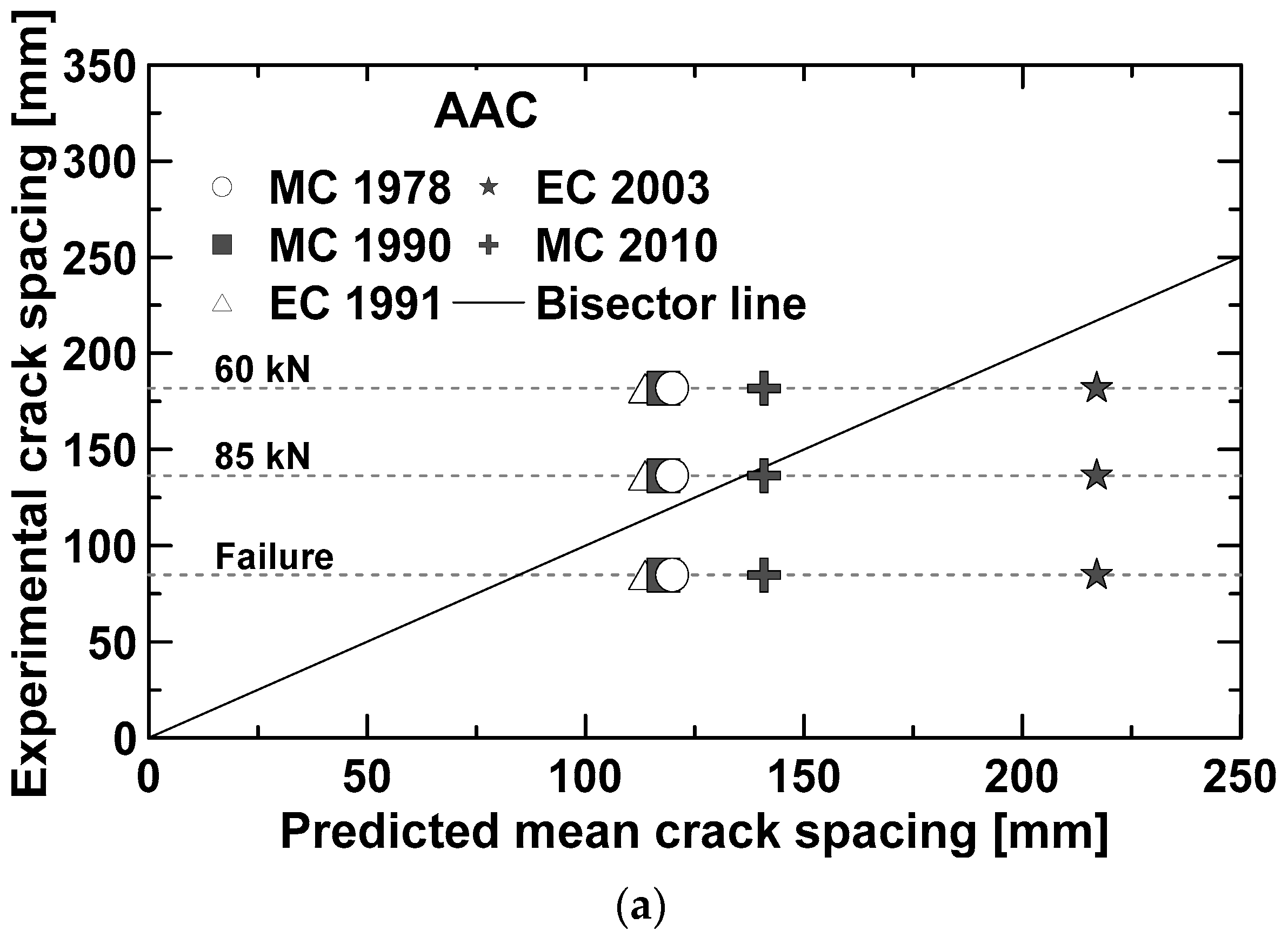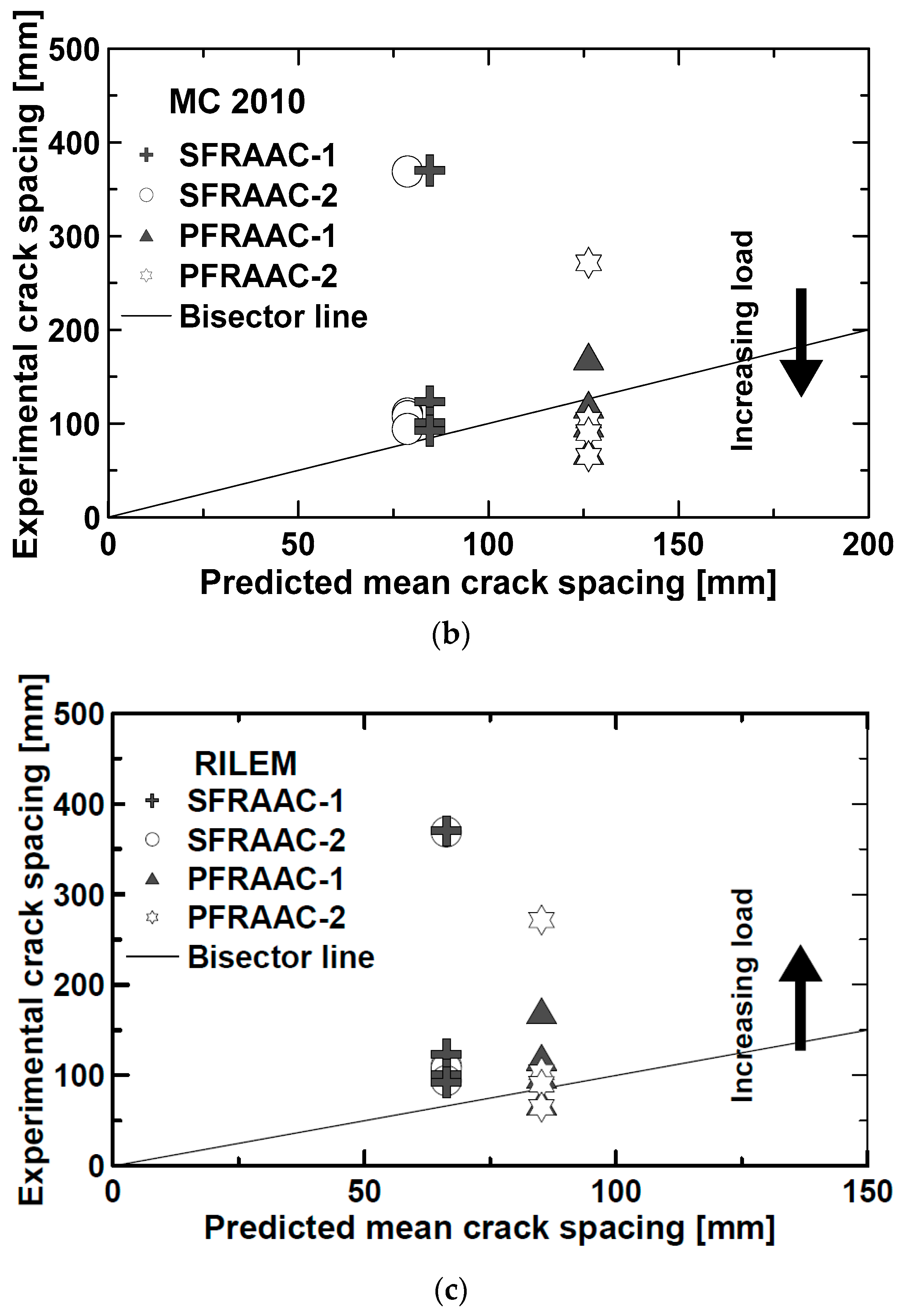Experimental Tests on Fiber-Reinforced Alkali-Activated Concrete Beams Under Flexure: Some Considerations on the Behavior at Ultimate and Serviceability Conditions
Abstract
1. Introduction
2. Experimental Program
2.1. Properties of the Test Beams
2.2. Materials
2.3. Test Set-Up and Instrumentation
3. Experimental Results and Discussion
3.1. Behavior at Ultimate Limit State (ULS)
3.2. Behavior at Serviceability Limit State (SLS)
4. Concluding Remarks
- -
- For the studied element geometry and longitudinal reinforcement ratio (ρl = 0.44%), the presence of fibers affected the structural failure mode by promoting a collapse due to rebar rupture; on the contrary, the reference element without fibers (AAC) experienced a classical failure due to concrete crushing.
- -
- The post-cracking strength of fibers, at ULS, developed a strain localization with a reduction of the portion of the bar under yielding. This determined an early rebar collapse, especially for steel fibers, which are more rigid and tougher compared to synthetic fibers. This peculiarity promoted a quite different local behavior well captured by the local moment–curvature diagrams observed: The section where the collapse occurred experienced a greater curvature, resulting in a corresponding larger local ductility, especially for FRC elements with higher post-cracking strengths (steel fibers). Conversely, the lower post-cracking strength observed in polymeric fibers tended to delay, in terms of midspan deformation, the final rebar collapse, resulting in a greater overall ductility (in terms of displacement), also possible thanks to the fiber ability to effectively promote a progressive decay of the concrete in compression.
- -
- Elements reinforced with steel fibers developed the lowest number of cracks at ULS, due to the strain localization, which might have caused a limited (not full) development of crack spacing.
- -
- The crack stabilizing stage for elements reinforced with fibers took place at a higher load level compared to non-fibrous elements; at the crack stabilizing stage, a good agreement between analytical and experimental crack spacing values was observed.
- -
- At SLS conditions, despite AAC beams experiencing a greater elastic modulus, fibers promoted an enhancement of the post-cracking stiffness with a consequent reduction of the midspan displacement and crack widths; a tension stiffening effect was seen to be more noticeable in elements reinforced with steel fibers where post-cracking strengths were greater.
Author Contributions
Funding
Acknowledgments
Conflicts of Interest
References
- Malhotra, V.M. Introduction: Sustainable development and concrete technology. Concr. Int. 2002, 24, 1147–1165. [Google Scholar]
- McLellan, B.C.; Williams, R.P.; Lay, J.; Van Riessen, A.; Corder, G.D. Costs and carbon emissions for geopolymer pastes in comparison to ordinary portland cement. J. Clean. Prod. 2011, 19, 1080–1090. [Google Scholar] [CrossRef]
- Attanasio, A.; Pascali, L.; Tarantino, V.; Arena, W.; Largo, A. Alkali-activated mortars for sustainable building solutions: Effect of binder composition on technical performance. Environments 2018, 5, 35. [Google Scholar] [CrossRef]
- Hardjito, D.; Wallah, S.E.; Sumajouw, D.M.; Rangan, B.V. On the development of fly ash-based geopolymer concrete. Mater. J. 2004, 101, 467–472. [Google Scholar]
- Sumajouw, D.M.J.; Hardjito, D.; Wallah, S.E.; Rangan, B.V. Behaviour and Strength of Reinforced Fly Ash-Based Geopolymer Concrete Beams. In Proceedings of the Australian Structural Engineering Conference, Newcastle, Australia, 11–14 September 2005. [Google Scholar]
- Sumajouw, M.D.J.; Rangan, B.V. Low-calcium fly ash-based geopolymer concrete: Reinforced beams and columns. In Research Report GC 3; Faculty of Engineering, Curtin University of Technology: Perth, Australia, 2006. [Google Scholar]
- Dattatreya, J.K.; Rajamane, N.P.; Sabitha, D.; Ambily, P.S.; Nataraja, M.C. Flexural Behaviour of Reinforced Geopolymer Concrete Beams. Int. J. Civ. Struct. Eng. 2011, 2, 138–159. [Google Scholar]
- Yost, J.R.; Radlińska, A.; Ernst, S.; Salera, M. Structural behavior of alkali activated fly ash concrete. Part 1: Mixture design, material properties and sample fabrication. Mater. Struct. 2013, 46, 435–447. [Google Scholar] [CrossRef]
- Yost, J.R.; Radlińska, A.; Ernst, S.; Salera, M.; Martignetti, N.J. Structural behavior of alkali activated fly ash concrete. Part 2: Structural testing and experimental findings. Mater. Struct. 2013, 46, 449–462. [Google Scholar] [CrossRef]
- American Concrete Institute (ACI) Committee 318. Building Code Requirements for Structural Concrete (ACI 318-08) and Commentary; American Concrete Institute: Farmington Hills, MI, USA, 2008. [Google Scholar]
- Prachasaree, W.; Limkatanyu, S.; Hawa, A.; Samakrattakit, A. Development of Equivalent Stress Block Parameters for Fly-Ash-Based Geopolymer Concrete. Arab. J. Sci. Eng. 2014, 39, 8549–8558. [Google Scholar] [CrossRef]
- Balaguru, P.N.; Shah, S.P. Fiber-Reinforced Cement Composites; McGraw-Hill Inc.: New York, NY, USA, 1992. [Google Scholar]
- Rossi, P.; Acker, P.; Malier, Y. Effect of steel fibres at two different stages: The material and the structure. Mater. Struct. 1987, 20, 436–439. [Google Scholar] [CrossRef]
- Minelli, F.; Plizzari, G. Derivation of a simplified stress–crack width law for Fiber Reinforced Concrete through a revised round panel test. Cem. Concr. Compos. 2015, 58, 95–104. [Google Scholar] [CrossRef]
- Conforti, A.; Minelli, F.; Plizzari, G.A.; Tiberti, G. Comparing test methods for the mechanical characterization of fiber reinforced concrete. Struct. Concr. 2018, 19, 656–669. [Google Scholar] [CrossRef]
- Mastali, M.; Abdollahnejad, Z.; Dalvand, A. Increasing the flexural capacity of geopolymer concrete beams using partial deflection hardening cement-based layers: A numerical study. Sci. Iranica. Trans. ACiv. Eng. 2017, 24, 2832–2844. [Google Scholar]
- Kheradmand, M.; Mastali, M.; Abdollahnejad, Z.; Pacheco-Torgal, F. Experimental and numerical investigations on the flexural performance of geopolymers reinforced with short hybrid polymeric fibres. Compos. Part B Eng. 2017, 126, 108–118. [Google Scholar] [CrossRef]
- Chilwesa, M.; Facconi, L.; Minelli, F.; Reggia, A.; Plizzari, G. Shrinkage induced edge curling and debonding in slab elements reinforced with bonded overlays: Influence of fibers and SRA. Cem. Concr. Compos. 2019, 102, 105–115. [Google Scholar] [CrossRef]
- Facconi, L.; Minelli, F. Verification of structural elements made of FRC only: A critical discussion and proposal of a novel analytical method. Eng. Struct. 2017, 131, 530–541. [Google Scholar] [CrossRef]
- Facconi, L.; Plizzari, G.; Minelli, F. Elevated slabs made of hybrid reinforced concrete: Proposal of a new design approach in flexure. Struct. Concr. 2019, 20, 52–67. [Google Scholar] [CrossRef]
- Germano, F.; Tiberti, G.; Plizzari, G. Post-peak fatigue performance of steel fiber reinforced concrete under flexure. Mater. Struct. 2016, 49, 4229–4245. [Google Scholar] [CrossRef]
- Monfardini, L. Alkali Activated Materials for Sustainable Structural Applications. Ph.D. Thesis, Department of Civil, Environmental, Architectural Engineering and Mathematics, University of Brescia, Brescia, Italy, 2017. [Google Scholar]
- Monfardini, L.; Minelli, F. Experimental Study on Full-Scale Beams Made by Reinforced Alkali Activated Concrete Undergoing Flexure. Materials 2016, 9, 739. [Google Scholar] [CrossRef]
- EN 12390-3. Testing Hardened Concrete—Part 3: Compressive Strength of Test Specimens; CEN-European Committee for Standardization: Brussels, Belgium, 2009. [Google Scholar]
- Fernandez-Jimenez, A.M.; Palomo, A.; Lopez-Hombrados, C. Engineering properties of alkali-activated fly ash concrete. ACI Mater. J. 2006, 103, 106–112. [Google Scholar]
- UNI EN 12390-13. Testing Hardened Concrete–Part 13: Determination of Secant Modulus of Elasticity in Compression; British Standards Institution: London, UK, 2013. [Google Scholar]
- Sofi, M.; Van Deventer, J.S.J.; Mendis, P.A.; Lukey, G.C. Engineering properties of inorganic polymer concretes (IPCs). Cem. Concr. Res. 2007, 37, 251–257. [Google Scholar] [CrossRef]
- Puertas, F.; Palacios, M.; Manzano, H.; Dolado, J.S.; Rico, A.; Rodríguez, J. A model for the C-A-S-H gel formed in alkali-activated slag cements. J. Eur. Ceram. Soc. 2011, 31, 2043–2056. [Google Scholar] [CrossRef]
- Provis, J.L.; van Deventer, J.S.J. Alkali-Activated Materials: State-Of-The-Art Report, RILEM TC 224-AAM; Springer/RILEM: Dordrecht, The Netherlands, 2014. [Google Scholar]
- EN 1992-1-1: Eurocode 2. Design of Concrete Structures. In Part 1-1: General Rules and Rules for Buildings; CEN-European Committee for Standardization: Brussels, Belgium, 2004. [Google Scholar]
- EN 14651-5. Precast Concrete Products—Test Method for Metallic Fibre Concrete-Measuring the Flexural Tensile Strength; CEN-European Committee for Standardization: Brussels, Belgium, 2005. [Google Scholar]
- Fib: Model Code for Concrete Structures 2010; Ernst & Son: Berlin, Germany, October 2013; 434p, ISBN 978-3-433-03061-5.
- EN 15630-1. Steel for the Reinforcement and Prestressing of Concrete—Part 1: Test Methods; CEN-European Committee for Standardization: Brussels, Belgium, 2004. [Google Scholar]
- Sarker, P.K. Bond strength of reinforcing steel embedded in fly ash-based geopolymer concrete. Mater. Struct. 2011, 44, 1021–1030. [Google Scholar] [CrossRef]
- Meda, A.; Minelli, F.; Plizzari, G.A. Flexural behaviour of RC beams in fibre reinforced concrete. Compos. Part B Eng. 2012, 43, 2930–2937. [Google Scholar] [CrossRef]
- Jansson, A.; Flansbjer, M.; Löfgren, I.; Lundgren, K.; Gylltoft, K. Experimental investigation of surface crack initiation, propagation and tension stiffening in self-compacting steel–fibre-reinforced concrete. Mater. Struct. 2012, 45, 1127–1143. [Google Scholar] [CrossRef]
- Minelli, F.; Tiberti, G.; Plizzari, G. Crack Control in RC Elements with Fiber Reinforcement. ACI Special Publication, ACI SP-280. Available online: http://www.cias-italia.it/PDF/PLIZZARI%20-%20Crack%20control%20in%20RC%20elements%20with%20Fiber%20Reinforcement.pdf (accessed on 12 October 2019).
- Euro-International du Béton and Fédération Internationale de la Précontrainte. In CEB–FIP Model Code for Concrete Structures, 3rd ed.; CEB–FIP: Paris, France, 1978.
- Comité Euro-International du Béton and Fédération Internationale de la Précontrainte. In CEB-FIP Model Code; CEB-FIP: Paris, France, 1990.
- EN 1992-1-1: Eurocode 2 (1991): Design of Concrete Structures—Part 1-1: General Rules and Rules for Buildings; CEN-European Committee for Standardization: Brussels, Belgium, 1991.
- EN 1992-1-1: Eurocode 2 (2003): Design of Concrete Structures—Part 1-1: General Rules and Rules for Buildings; CEN-European Committee for Standardization: Brussels, Belgium, 2003.
- RILEM T C162-T. Test and design methods for steel fiber reinforced concrete. Mater. Struct. 2003, 36, 560–567. [Google Scholar] [CrossRef]











| Specimen Designation | B | h | L | ρl | Type of Fibers | Fiber Content | Fiber Volume Fraction (Vf) |
|---|---|---|---|---|---|---|---|
| [mm] | [mm] | [mm] | [%] | [-] | [kg/m3] | [%] | |
| AAC | 200 | 460 | 4500 | 0.44 | No fibers | - | - |
| SFRAAC-1 | Hooked-end steel | 25 | 0.3 | ||||
| SFRAAC-2 | |||||||
| PFRAAC-1 | Synthetic Macrofiber—Embossed | 3 | 0.3 | ||||
| PFRAAC-2 |
| Al2O3 | SiO2 * | CaO | Fe2O3 | MgO | K2O | Na2O | TiO2 | SO3 |
|---|---|---|---|---|---|---|---|---|
| (%) | (%) | (%) | (%) | (%) | (%) | (%) | (%) | (%) |
| 28 | 56 | 2 | 5.5 | 0.2 ÷ 3 | 0.2 ÷ 2 | 0.1 ÷ 0.6 | 0.1 ÷ 1.7 | 0.2 ÷ 2 |
| Property | Unit | Test Beams | ||||
|---|---|---|---|---|---|---|
| AAC | SFRAAC-1 | SFRAAC-2 | PFRAAC-1 | PFRAAC-2 | ||
| Em | [GPa] | 23.5 (4.0%) | 18.2 (3.0%) | 18.7 (1.0%) | 18.1 (1.0%) | 18.6 (2.0%) |
| εcm | [‰] | 3.1 (1.8%) | 5.0 (6.0%) | 3.4 (12.8%) | 2.8 * | 2.8 * |
| Rcm | [MPa] | 37.0 (4.1%) | 45.0 (2.2%) | 34.0 (8.5%) | 40.0 (2.0%) | 36.0 (3.3%) |
| fcm | [MPa] | 37.0 (1.0%) | 27.0 (0.4%) | 24.0 (2.9%) | 24.0 (11.0%) | 24.0 (11.0%) |
| Rcm/fcm | [-] | 1.0 | 1.7 | 1.4 | 1.7 | 1.5 |
| fck | [MPa] | 34.5 | 25.5 | 20.9 | 22.8 | 22.7 |
| fctm | [MPa] | 3.2 | 2.6 | 2.3 | 2.4 | 2.4 |
| fL | [MPa] | 3.6 * | 3.6 (0.6%) | 3.9 (5.7%) | 3.8 (15.7%) | 3.6 (6.0%) |
| fR1 | [MPa] | 0.37 * | 3.3 (31.5%) | 3.3 (2.4%) | 0.7 (4.0%) | 0.9 (4.7%) |
| fR2 | [MPa] | - | 3.2 (39.8%) | 3.3 (2.0%) | 0.7 (5.0%) | 0.9 (3.5%) |
| fR3 | [MPa] | - | 2.9 (43.2%) | 3.0 (0.6%) | 0.8 (4.2%) | 1.0 (8.1%) |
| fR4 | [MPa] | - | 2.6 (46.3%) | 2.7 (3.3%) | 0.8 (1.9%) | 1.0 (8.3%) |
| Specimen | Pmax | MR,max,exp | x | MR,max,anl | Øu | Øy | μØ | δu | δy | μδ |
|---|---|---|---|---|---|---|---|---|---|---|
| [kN] | [kNm] | [mm] | [kNm] | [1/km] | [1/km] | [-] | [mm] | [mm] | [-] | |
| AAC | 130 | 104 | 36.1 | 95 | 80 | 12 | 6.67 | 92 | 20 | 4.65 |
| SFRAAC-1 | 141 | 113 | 59.4 | 116 | 246 | 18 | 13.67 | 132 | 19 | 6.96 |
| SFRAAC-2 | 146 | 117 | 59.4 | 116 | 139 | 16 | 8.69 | 93 | 17 | 5.49 |
| PFRAAC-1 | 140 | 112 | 43.8 | 102 | 175 | 20 | 8.75 | 194 | 18 | 10.8 |
| PFRAAC-2 | 140 | 112 | 43.8 | 102 | 174 | 26 | 6.69 | 173 | 19 | 9.1 |
| Specimen | Δ0.30 | Δ0.45 | Δ0.70 |
|---|---|---|---|
| [mm] | [mm] | [mm] | |
| AAC | - | - | - |
| SFRAAC-1 | −0.32 (−16%) | −1.84 (−35%) | −3.14 (−26%) |
| SFRAAC-2 | −0.36 (−17%) | −2.11 (−40%) | −3.12 (−26%) |
| PFRAAC-1 | −0.34 (−17%) | −0.67 (−13%) | −1.64 (−11%) |
| PFRAAC-2 | −0.03 (−1.2%) | −0.37 (−7%) | −0.80 (−7%) |
© 2019 by the authors. Licensee MDPI, Basel, Switzerland. This article is an open access article distributed under the terms and conditions of the Creative Commons Attribution (CC BY) license (http://creativecommons.org/licenses/by/4.0/).
Share and Cite
Monfardini, L.; Facconi, L.; Minelli, F. Experimental Tests on Fiber-Reinforced Alkali-Activated Concrete Beams Under Flexure: Some Considerations on the Behavior at Ultimate and Serviceability Conditions. Materials 2019, 12, 3356. https://doi.org/10.3390/ma12203356
Monfardini L, Facconi L, Minelli F. Experimental Tests on Fiber-Reinforced Alkali-Activated Concrete Beams Under Flexure: Some Considerations on the Behavior at Ultimate and Serviceability Conditions. Materials. 2019; 12(20):3356. https://doi.org/10.3390/ma12203356
Chicago/Turabian StyleMonfardini, Linda, Luca Facconi, and Fausto Minelli. 2019. "Experimental Tests on Fiber-Reinforced Alkali-Activated Concrete Beams Under Flexure: Some Considerations on the Behavior at Ultimate and Serviceability Conditions" Materials 12, no. 20: 3356. https://doi.org/10.3390/ma12203356
APA StyleMonfardini, L., Facconi, L., & Minelli, F. (2019). Experimental Tests on Fiber-Reinforced Alkali-Activated Concrete Beams Under Flexure: Some Considerations on the Behavior at Ultimate and Serviceability Conditions. Materials, 12(20), 3356. https://doi.org/10.3390/ma12203356







